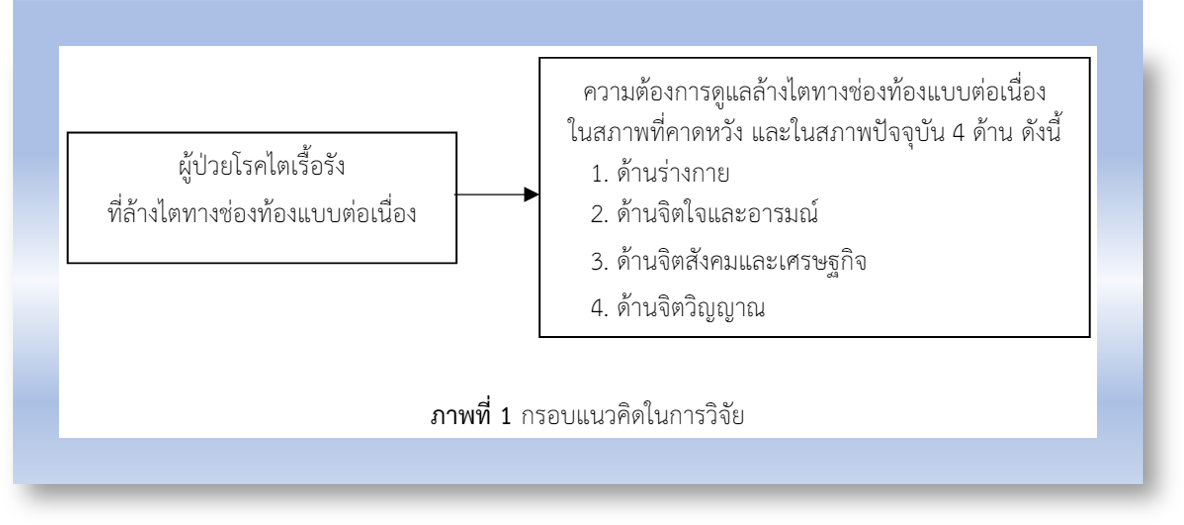ความต้องการของผู้ป่วยโรคไตเรื้อรังที่ได้รับการล้างไตทางช่องท้องแบบต่อเนื่อง
คำสำคัญ:
ความต้องการของผู้ป่วยโรคไตเรื้อรัง, การล้างไตทางช่องท้องแบบต่อเนื่อง, ผู้ป่วยโรคไตเรื้อรังบทคัดย่อ
การวิจัยเชิงสำรวจนี้ มีวัตถุประสงค์เพื่อประเมินและจัดลำดับความต้องการของผู้ป่วยโรคไตเรื้อรังที่ได้รับการล้างไตทางช่องท้อง กลุ่มตัวอย่าง จำนวน 109 คน ที่รับบริการในโรงพยาบาลพระนารายณ์มหาราช คัดเลือกกลุ่มตัวอย่างโดยวิธีสุ่มอย่างง่าย เครื่องมือ คือ แบบสอบถามความต้องการของผู้ป่วยโรคไตเรื้อรังที่ได้รับการล้างไตทางช่องท้อง ความตรงเชิงเนื้อหา (IOC) เท่ากับ 1.00 ความเชื่อมั่นสัมประสิทธิ์แอลฟาของครอนบาค เท่ากับ .84 วิเคราะห์ข้อมูลด้วยค่าเฉลี่ย ร้อยละ และ Modified Priority Needs Index
ผลการวิจัย พบว่า ความต้องการของผู้ป่วยโรคไตเรื้อรังที่ล้างไตทางช่องท้องภาพรวมอยู่ในระดับมากที่สุด ความต้องการรายด้าน 3 ลำดับแรก คือ 1) ด้านจิตสังคมและเศรษฐกิจ (PNImodified = .08) 2) ด้านจิตวิญญาณ (PNImodified = .05) และ 3) ด้านร่างกาย (PNImodified = .04) และรายข้อ 3 ลำดับแรก คือ 1) การเยี่ยมบ้านจากบุคลากรทางการแพทย์ (PNImodified = .18) 2) ความช่วยเหลือด้านอุปกรณ์ทำแผล และหน้ากากอนามัยอย่างเพียงพอ (PNImodified = .15) และ 3) การปฏิบัติบทบาทหน้าที่ให้กับครอบครัวเหมือนที่เคยปฏิบัติก่อนการรักษาด้วยการล้างไตทางหน้าท้อง (PNImodified = .14) จากผลการศึกษานี้ บุคลากรทางการแพทย์ควรเยี่ยมบ้านมากขึ้น เพิ่มการจัดสรรอุปกรณ์สำหรับล้างไตทางหน้าท้องให้เพียงพอ และส่งเสริมการรับรู้สมรรถนะแห่งตนในบทบาทของผู้ป่วยให้ใกล้เคียงก่อนการรักษาด้วยการล้างไตทางหน้าท้อง แบบต่อเนื่อง
เอกสารอ้างอิง
National Health Security Office. Annual national health security system creation report 2016-2018 [Internet]. 2019 [cited 2021 Dec 20]. Available from: http://www.nhso.go.th (in Thai)
Nguyen B, Bui QTH, Tran PQ. Survival rates in elderly patients on continuous ambulatory peritoneal dialysis. International Journal of Nephrology and Renovascular Disease 2023;16:131-41. doi: 10.2147/ijnrd.s397555.
Vientini CA, Ponce D. Comparative analysis of patients’ survival on hemodialysis vs. peritoneal dialysis and identification of factors associated with death. Journal Brasileiro De Nefrologia 2023;45(1):8-16. doi: 10.1590/2175-8239-jbn-2021-0242en.
Bitar W, Helve J, Kanerva M, Honkanen E, Rauta V, Haapio M, et al. Severe infections in peritoneal dialysis and home hemodialysis patients: an inception cohort study. PLoS ONE 2023;18(6):e0286579. doi: 10.1371/journal.pone.0286579.
Wongsabut P, Prapaipanich W, Malatham P. Self-Care behavior among persons with continuous ambulatory peritoneal dialysis experiencing complications. Journal of Nursing and Health Care 2017;35(2):1-10. (in Thai)
Kankarn W. PD first policy holistic nursing in CAPD patients: challenge role under PD first policy. Journal of Nursing and Health Care 2015;33(4):6-14. (in Thai)
Muksirithipanan B, Phongsatornwiboon K, Jensuwan M, Wongrostrai Y, Soowit B. Spiritual well-being and needs among patients with end-stage renal disease, faculty of medicine Vajira hospital, Navamindradhiraj university. Songklanakarin Journal of Nursing 2018;38(1):63-76. (in Thai)
Sledge R, Oncepcion BP, Witten B, Klicko K, Schatell D. Kidney failure patients’ perception and definitions of health: qualitative study. Kidney Medicine 2023;5(4):1006003. doi: 10.1016/j.xkme.2023.100603.
Annapanurak R, Manit A. Development of nursing service system among chronic kidney disease patients receiving continuous ambulatory peritoneal dialysis by using case management concept at King Narai hospital, Lop Buri. Thai Journal of Cardio - Thoracic Nursing 2015;26(1):133-48. (in Thai)
Towannang P, Sriyuktasute A, Wattanakitkrileart D, Kanjanabuch T. Hand hygiene behaviors associated with peritoneal dialysis-related infection. Journal of Health Research 2023;37(4):208-16. doi: 10.56808/2586-940X.1028. (in Thai)
Wongvanich S. Research to assess the need for necessity. 3rd ed. Bangkok: Chulalongkorn University; 2015. (in Thai)
Ding XR, Huang H, Liao YM, Zhu JR, Tang W, Fang XW, et al. Daily self-care practices influence exit-site condition in patients having peritoneal dialysis: a multicenter cross-sectional survey. Journal of Advanced Nursing 2021;77(5):2293-306. doi: 10.1111/jan.14751.
Sarakwan J, Sittisongkarm S, Boonkerd M, Khrabiad S, Meepaen M. Quality of life in patients with end stage of renal disease. Journal of Phrapokklao Nursing College 2017;28(2):153-64. (in Thai)
Kim YJ, Choi O, Kim B, Chun J, Kang KA. Comparison of spiritual needs between patients with progressive terminal kidney disease and their family caregivers. The Korea Journal of Hospice and Palliative Care 2020;23(1):27-38. doi: 10.14475/kjhpc.2020.23.1.27.
Sukrungruang I, Rongmuang D. The development of guideline to promote healthcare behavior through mobile health (mhealth) application on peritoneal dialysis complication and quality of life in patients undergoing peritoneal dialysis during COVID-19 situation.
Journal of Phrapokklao Nursing College 2021;32(1):171-88. (in Thai)
Kanjanabuch T, Pongpirul K. Peritoneal dialysis are during the COVID-19 pandemic, Thailand. Bulletin of World Health Organization 2022;100(2):155-60 doi: 10.2471/BLT.21.286792.
Shamy OE, Tran H, Sharma S, Ronco C, Narayanan M, Uribarri J. Telenephrology with remote peritoneal dialysis monitoring during coronavirus disease 19. American Journal of Nephrology 2020;51:480-2. doi: 10.1159/000508023.
Polanco E, Quey M, Collado J, Campos E, Guzman J, Cuevas-Budhart MA, et al. A COVID-19 pandemic-specific, structured care process for peritoneal dialysis patients facilitated by telemedicine: therapy continuity, prevention, and complications management. Therapeutic Apheresis and Dialysis 2021;25(6):970-8. doi: 10.1111/1744-9987.13635.

ดาวน์โหลด
เผยแพร่แล้ว
รูปแบบการอ้างอิง
ฉบับ
ประเภทบทความ
สัญญาอนุญาต
ลิขสิทธิ์ (c) 2024 วารสารเกื้อการุณย์

อนุญาตภายใต้เงื่อนไข Creative Commons Attribution-NonCommercial-NoDerivatives 4.0 International License.














